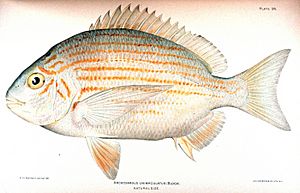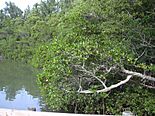Western Atlantic seabream facts for kids
Quick facts for kids Western Atlantic seabream |
|
|---|---|
 |
|
| Conservation status | |
| Scientific classification | |
| Synonyms | |
|
The Western Atlantic seabream (Archosargus rhomboidalis) is a type of fish that lives in the ocean. It belongs to the Sparidae family, which includes many kinds of seabreams. This fish was first described in 1758 by a famous scientist named Carl Linnaeus. He is known as the "father of modern taxonomy" because he created the system we use to name living things.
People sometimes call this fish by other names like seabream, brim, tropical sheepshead, chopa amarilla, or salema. Even though people eat them, Western Atlantic seabream are not as popular for sport fishing as their cousin, the sheepshead.
Contents
About the Western Atlantic Seabream's Name
The Western Atlantic seabream got its scientific name from Carl Linnaeus in 1758. He first put it in a group of fish called Perca. This group now includes freshwater fish like the yellow perch. Later, scientists moved the Western Atlantic seabream to its current group, Archosargus.
Another scientist, Marcus Elieser Bloch, also described this fish in 1792. He called it Archosargus unimaculatus. However, that name is no longer used.
What Does the Western Atlantic Seabream Look Like?
The Western Atlantic seabream looks a lot like its relative, the sheepshead. But there are some key differences. Western Atlantic seabream are smaller. They have several blue stripes that run across their bodies, mixed with gold or yellow colors. They also have a dark spot on their shoulder.
Young Western Atlantic seabream have vertical stripes, similar to sheepshead. However, these stripes fade away as the fish gets older.
Size and Features
The longest Western Atlantic seabream ever found was about 33 centimeters (about 13 inches) long. Most of them usually grow to about 20 centimeters (about 8 inches). The heaviest one recorded weighed about 0.55 kilograms (about 1.2 pounds).
These fish have nine strong spines on their dorsal fin (the fin on their back). They also have 10 or 11 soft rays on this fin. On their anal fin (the fin on their belly), they have three spines and the same number of soft rays.
You can tell male and female Western Atlantic seabream apart by the color of their pelvic fins (the fins on their underside). Males have fins that are partly or completely dark. Females have orange pelvic fins.
Where Do Western Atlantic Seabream Live?
Western Atlantic seabream live in the waters from New Jersey down to Argentina. You can find them in the northern Gulf of Mexico and many parts of the West Indies. Interestingly, they are not found near the Bahamas.
Their Habitat
These fish often live in mangrove swamps. They also like areas with muddy bottoms or lots of plants. Sometimes, they are found in brackish water, which is a mix of fresh and saltwater. They can also be seen near reefs that are close to mangroves.
Western Atlantic seabream mostly eat small creatures that live on the seafloor. These include things like bivalves (like clams) and crustaceans (like crabs). They also eat aquatic plants. These fish can live for up to two years in the wild.




